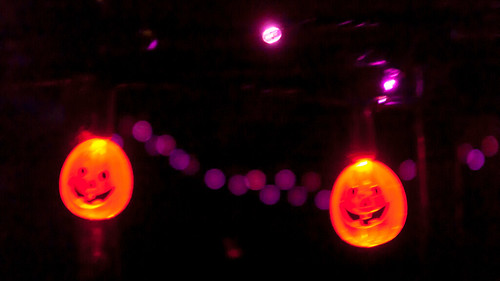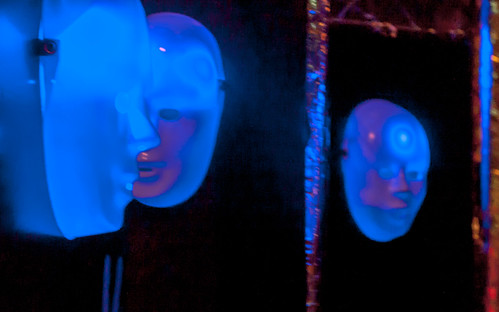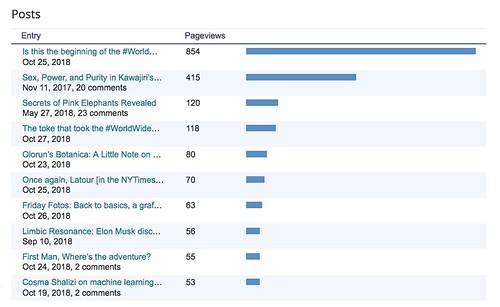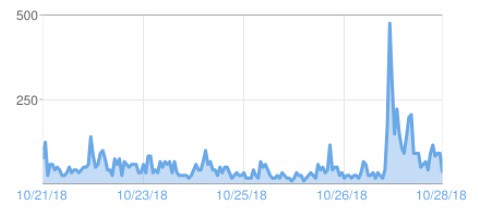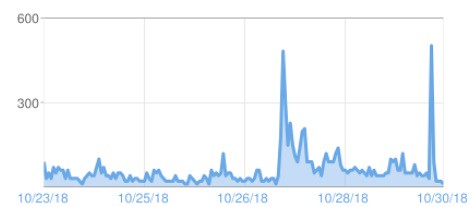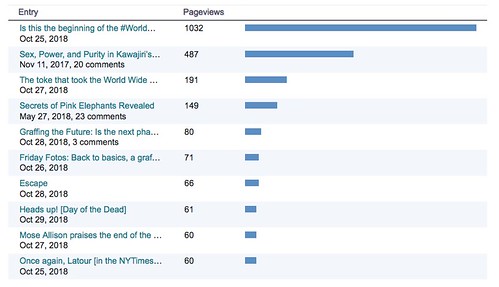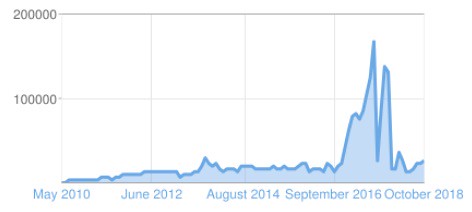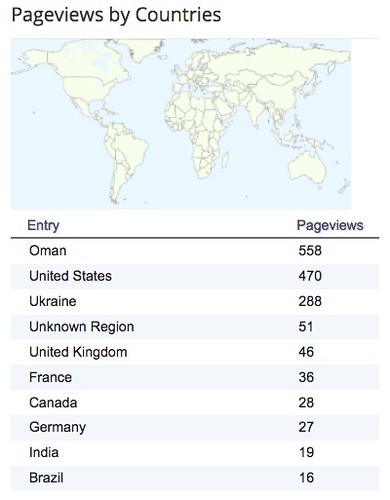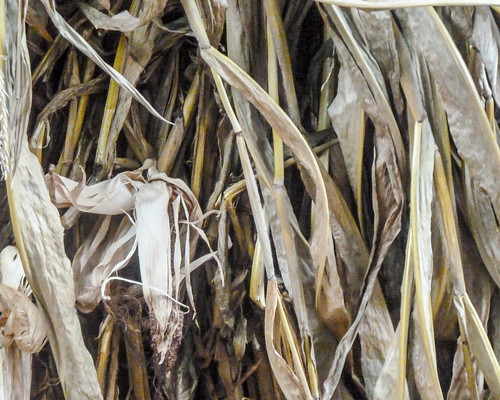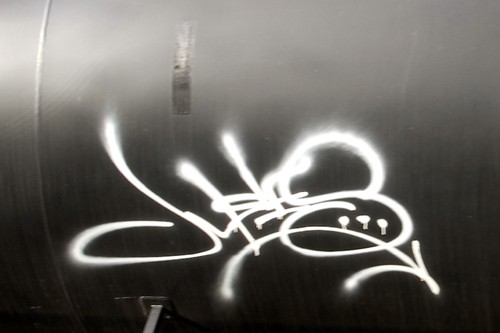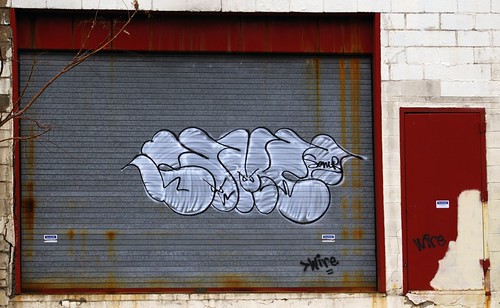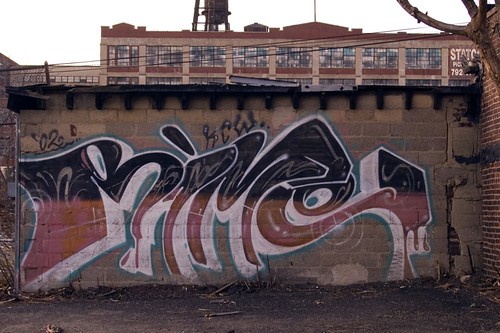This is excellent work. It also underscores the category mistake often made by linguists of confounding syntax with semantics in reasoning. E.g. recursive thought need not imply recursive syntax. https://t.co/4m8LSD5ZKk— Daniel Everett (@amazonrambler) October 31, 2018
Wednesday, October 31, 2018
Tweet of the day: The primacy of semantics over syntax in language
Cybernetic Trump, dominating the public arena
I recently posted a cybernetic analysis of Donald Trump’s presidency, Trumposaurus Rex @ 3QD – Toward a cybernetic interpretation. This is a relatively short (I hope) elaboration of that.
The idea is that, above all else, what Trump cares about his that he dominates the media, something he’s been able to do at least since he won the Republican nomination, if not before that. That’s what he cares about, how he appears in the media, cable news in particular, and that he’s driving the news cycle with his tweets, rallies, and whatever else he gets out there through press conferences, interviews, whatever.
What does that mean, concretely?
Controlling activity on the web
Let me digress to a quick look at my own very very modest media activity, primarily the papers I post at Academia.edu. Here’s some of the standard analytics available for users:
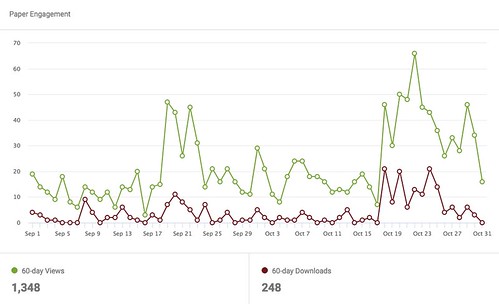
This depicts activity on my Academia.edu account over the last 60 days. The upper (green) line shows page views while the lower (brown) line shows downloads.
Notice that there are two dramatic increases in activity. One limited to about a week in the middle of September and the other starting in the middle of October and still going. Those are not accidents or flukes. I made those increases happen, consciously and deliberately. And I was able to do so precisely because I could examine those analytics and thus see the relationship between my activity, posting papers to the site as well as tweeting about them, and the response to that activity.
In the earlier case I’d posted a working paper about the Avita Ronell scandal. It had been dominating certain segments of the academic internet, blogs and Twitter in particular, and I had been contributing by writing my own posts. I gathered them into a single document and posted the to Academia. Now, this is something I do regularly (gather posts into a working paper ...), so there’s nothing unusual about that. But, knowing that this scandal was hot, at least in certain quarters, I figured I’d see a boost in interest in my Academia site. I was right, and I could see that it was that working paper that interested people.
That second increase is more complicated. I’d uploaded a relatively short piece with no particular expectations about its performance. I had it around and figured I’d upload it. But, for whatever reason, it generated a fair amount of action. So I uploaded another similar piece, and the action continued. I also uploaded a somewhat different short piece, with no particular expectations. But: Bingo! So, another short piece. Bingo! And a longer piece (like the first two shorts). OK, a little action.
What are the chances that I can keep it going? Off hand, not good. I just don’t have that much of what seems to be the right material to keep it going. No matter.
The point simply is that I was had a measure of control over what happened. Anyone who is active on the web has access to this kind of control. You make an action, see what happens, and adjust your strategy accordingly.
If you’re into that kind of thing. Which I am.
And so is Trump
But not specifically the web. Rather, all media: internet, broadcast TV, cable TV, newspapers and newsmagazines. He’s needy and greedy. He wants it all.
How’d he get it? He’s good news, by which I mean he does things that people will read about and will watch. And so he sells advertising dollars, which are particularly attractive to the (f)ailing MSM (mainstream media).
Why’s he such good news? Everyone has an opinion about that, but so what? The one thing most pundits seem to agree on is that he’s given a public voice to a large number of people who, rightly or wrongly, have felt neglected. The Base, Trump’s hardcore followers, who haven’t wavered in their support.
And they’re going the same thing I do when I look at my analytics and that Trump does when he watches cable news. They’re seeing themselves, their interests, and their actions reflected in the news. They cheer at the rallies and the media reports those rallies. The retweet Trump’s tweets and that keeps the ball rolling.
There’s a new game afoot, and so far Trump’s winning it.
What are we to do?
What to you mean WE, masked man?
The idea that Trump is stupid, which is popular in certain spheres, is dangerous and wrong. He may be reckless and narcissistic, but he’s not stupid. To be sure, he seems devoid of reflective analytic intelligence. But he knows how to work the news cycle. Call it animal cunning amplified by modern media. That’s what it is; stupid it is not.
* * * * *
On the use of web analytics to understand and even control action around you, see also my post, Getting a boost from Marginal Revolution, or into the weeds with stats [#EmergentVentures #WorldWideWall]
Collaboration networks in the selection of drum samples for hip-hp
Mason Youngblood, Cultural transmission modes of music sampling traditions remain stable despite delocalization in the digital age, arXiv:1810.11900v1 [stat.AP]
Music sampling is a common practice among hip-hop and electronic producers that has played a critical role in the development of particular subgenres. Artists preferentially sample drum breaks, and previous studies have suggested that these may be culturally transmitted. With the advent of digital sampling technologies and social media the modes of cultural transmission may have shifted, and music communities may have become decoupled from geography. The aim of the current study was to determine whether drum breaks are culturally transmitted through musical collaboration networks, and to identify the factors driving the evolution of these networks. Using network-based diffusion analysis we found strong evidence for the cultural transmission of drum breaks via collaboration between artists, and identified several demographic variables that bias transmission. Additionally, using network evolution methods we found evidence that the structure of the collaboration network is no longer biased by geographic proximity after the year 2000, and that gender disparity has relaxed over the same period. Despite the delocalization of communities by the internet, collaboration remains a key transmission mode of music sampling traditions. The results of this study provide valuable insight into how demographic biases shape cultural transmission in complex networks, and how the evolution of these networks has shifted in the digital age.
Tuesday, October 30, 2018
Getting a boost from Marginal Revolution, or into the weeds with stats [#EmergentVentures #WorldWideWall]
Last Thursday, October 25, 2018, I ran up a post entitled, Is this the beginning of the #WorldWideWall ?. The post consisted of five tweets from Leonard Bogdonoff, who had gotten a grant from Tyler Cowen’s Emergent Ventures “to create a genealogy of street art, using machine learning.” That got my attention for two reasons: 1) I’m interested in Emergent Ventures, and 2) I’m interested in both graffiti and machine learning.
When I looked Bogdonoff’s tweets that morning I realized that, for all practical purposes, he’d begun work assembling what I have been calling the World-Wide Wall, all of the world’s outward facing graffiti and street art assembled into one gigantic and searchable object in cyberspace via photographs on the web. So I assembled that post and then emailed a link to Tyler Cowen in which I congratulated him on a shrewd first pick. I came this > < close to saying “the eagle has landed.” Tyler emailed me back, indicating that he’d post a link on Saturday. Saturday roles around and there it is, the link:
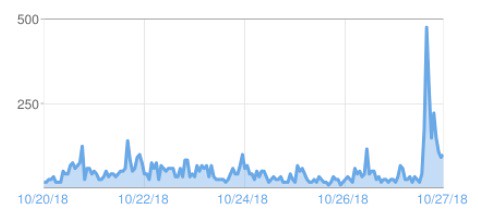

That shows web traffic to New Savanna for the previous week. That spike is the effect of Cowen’s link on my web traffic.
This chart shows the top 10 posts for the preceding week, measured starting the 27th:
At 854, the #WorldWideWall post is first. Most, though not all, of those hits are traffic from Cowen’s blog, Marginal Revolution, which he runs with Alex Tabarrok. The next two posts, Sex, Power, and Purity in Kawajiri’s Ninja Scroll, and “Secrets of Pink Elephants Revealed”, are the most popular posts here, and have been up for several years.
Here’s shot of the previous week’s posts that I took on Sunday, the 28th:
The effects of Cowen’s link are still quite visible.
And again, earlier this morning:
Cowen’s spike is still prominent, but another spike has appeared. I haven’t got the foggiest idea what’s driving it. The increase in traffic is probably distributed across many posts.
This post shows the top 10 posts for the immediate week, measured backward from this morning:
Again, “WorldWideWall is tops, Ninja Scroll is second, but Pink Elephants has slipped into fourth behind “The toke that took World Wide Web and smoked the #MSM”, about Elon Musk. That post is related to graffiti and Bogdonoff and so may have benefited indirectly from Cowen’s link, but not, I feel, enough to account for that new spike. If I had more information I might be able to figure this out. But I don’t.
Finally, this chart shows New Savanna’s traffic over the span of its life from April 2010 to present:
Notice that there’s a huge increase in traffic for roughly 2016. I have no idea why that happened. At one time or another I thought it might be centered on my photographs, but I really don’t know.
More later.
Addendum: I found the source of today’s spike: Oman. Here’s a chart of today’s traffic grouped by country of origin:
Oman is at the top with 558 hits, followed by the United States, which generates by far the largest fraction of my traffic, and then Ukraine, which also provides a fair but of traffic. I have no idea about the source of that traffic from Oman; it could be just one or a half-dozen curious people. Who knows? The fact that no single post shows an unusual uptick in traffic suggests a small number of people each browsing a bunch of posts.
Monday, October 29, 2018
RHYTHM NOTES: Polyrhythms – Construction, Practice, Performance
A new working paper. Abstract, contents, and introduction below. Download here:
- Academia.edu: https://www.academia.edu/37668786/RHYTHM_NOTES_Polyrhythms_Construction_Practice_Performance
- Scribd: https://www.scribd.com/document/391883858/RHYTHM-NOTES-Polyrhythms-Construction-Practice-Performance
ABSTRACT: A series of notes about learning to play patterns, especially polyrhythms on a tongue drum with six tongues. 2 against 3, 3 against, 4, different stroking patterns, early learning and then phase changes when moving from slow to fast tempos, when moving from learning to consolidation and then performance. Becoming fluid at switching between different fixed patterns on to free improvisation, where you play any pattern you are capable of playing in whatever order you choose. Conscious and deliberate effort vs. automatic, unconscious and spontaneous play. The layout of musical ‘space’ for different instruments: drums, trumpet, piano, strings.
C O N T E N T S
What’s Up? I’ve always been a tapper 2
Learning Polyrhythms 5
Free-Drumming and Visual-Motor Space 9
Musical Space 13
Recruitment 13
Divisions of the Motor System 14
Repetition & the Inner Other 14
Timing and Pattern Stability 15
Streaming 20
Free Drumming, etc. 21
Adding Electronic Drum to the Repertoire 22
WHAT’S UP? I’VE ALWAYS BEEN A TAPPER
I’ve always been a tapper, my toes, my fingers on the table, whatever. We are, after all, rhythm machines. But when it came time to learn a musical instrument I choose trumpet and then, a few years later, piano. When I was living in Baltimore and going to Johns Hopkins I bought some used conga drums at Ted’s Music in Baltimore, a wonderful place, by the way, and still in business and taught myself how to get some decent sounds out of them. I even performed on them in public, on a few occasions.
When I moved to Troy, NY, I’d go to the Newport Festival, I believe it was, in Saratoga Springs. And one summer, most likely in the early 1980s, I bought this tongue drum:
A single glance tells you why it’s called a tongue drum, you play those wooden tongues. The different tongues give you different quasi-pitches. I say “quasi” because none of them have a well defined pitch center, but the tongues are clearly high or low in proportion to their length. The last time I went into a drum store (in New York City) to get another tongue drum I discovered that they’re all tuned to a pentatonic scale, which is OK if you’re looking for a melodic instrument, which I wasn’t. I prefer the less precisely tuned drum.
Some of the tongues are more responsive than others, so you have to do a bit of exploring to find the “sweet spot” for each tongue. And then you have to be sure to hit that spot each time you hit the tongue, unless, of course, you want a deader sound. Which is to say that you don’t just bang on the drum. You have to learn to work with it, learn how best it speaks. There are subtleties.
Always, there are subtleties.
That’s what these notes are about, not necessarily the subtleties, though sometimes, but about learning to play these drums, and bells as well (such as those on the cover page). Though I’d been tapping on them on and off ever since I’d bought them it wasn’t until early in this century (and millennium too) that I started systematically practicing them. By that time I’d been corresponding with the late Walter Freeman, the Berkeley neurobiologist, about the brain and music, so I started corresponding with him about learning to play these drums. Most, though not all, of the notes I’ve gathered here come from that correspondence, much of which was directed to Ralph Holloway as well. Holloway is a physical anthropologist at Columbia who is interested in the brains of early humans and pre-human hominins; he’s also a trumpet player.
◆◆◆
Learning Polyrhythms: To Walter Freeman: Playing drag triplets when young (three notes strung over a pair of toe taps). 30 years later, two against three, where I began playing bells, occasional balaphone, and the tongue drum; 2 against 3, 3 against 2 finally clicked and consolidated within a day or two. Then I went on to 3 against 4, somewhat harder (still not solid, though I’ve not tried in awhile). And then there’s some comments on breathlessness while playing the trumpet. I’ve written a set of variations on Thelonius Monk’s “Epistrophy”, where the first and third movements involve a bit of polyrhythmic trickery. When playing those I find myself getting out of breath more rapidly than is consistent with the physical difficulty involved. I speculate: “I’m guessing that the rhythmic complexity of the music brings about a different entrainment with physiology and that’s what’s making me breathless.”
Free-Drumming and Visual-Motor Space: To Walter Freeman and Ralph Holloway: “I noticed something interesting the other day that has to do with “free drumming” (to be defined). I seemed to be making choices in visual-motor space rather than auditory space. This is quite different from what I do when improvising on the trumpet, where I seem to make choices in auditory space. That is to say, when playing the trumpet I make choices in terms of what I want to hear rather than in terms of what I want my body to do. I’m not sure whether or not this is because I’m considerably more expert on the trumpet than on my drum.” Responses from both Freemand and Holloway and replies to both.
Musical Space: To myself: A continuation of the previous discussion where I consider the musical spaces of the piano and stringed instruments.
Recruitment: To myself: The idea is that the “impact,” “effect,” or “meaning,” of later passages depends on recruitment resulting from the earlier passages.
Divisions of the Motor System: To myself: I suspect that different levels of “psych” involve differing levels of recruitment of three different types of muscle fibers.
Repetition & the Inner Other: To myself: For the past two or three weeks I’ve noticed a subtle difference when I play a pattern on the tongue drum and hold it. It feels as though some “other being” is gently participating in my playing, making things a little steadier.
Timing and Pattern Stability: To Freeman, Freeman replies, and I reply to him: This is about stroking patterns for playing triplets (say, LRR LRR LRR... vs. LRL RLR LRL ...) alternating between high and low tones and then switching between stroke patterns. Sounds tricky. Freeman’s comment: “Yes, it's [Benjamin] Libet's territory, also Scott Kelso and his finger motion, which is the kind of state transition you describe, only his was much simpler, a shift from in phase to anti-phase locking with increasing tempo. He modeled that with Haken's synergetics.” There’s more (there’s always more).
Streaming: From a note to Sasha Shulgin: Streaming – the way different notes group themselves into perceptually different melodic streams – has practical consequences for musicologists trying to transcribe the different components of West African drum ensembles. It is all but impossible to figure out who's playing what line simply by listening to the sound and watching the players. Now, if you're a player in the middle of this . . . what's the subjective effect of being unable to hear who's doing what?
Free Drumming, etc.: To Freeman and Holloway: About two or three weeks ago I was doing some free drumming and things began “clicking” in a way they never had before. I was able to improvise long phrases of some complexity that, all of a sudden, made sense to me. Improvement since that time has been steady and rapid. The important stuff was simply learning to play repetitive patterns, lots of them, and to switch smoothly from one pattern to another. In fact, I would say that the main function of free drumming over the past year was to force some fluidity into my playing.
Adding Electronic Drum to the Repertoire: To Freeman and Holloway: This is about what happens when I start playing electronic drums. The playing surface changes, both in arrangment of surfaces and in the physical property of those surface. I now have a large array of sounds available to me. And, when I add the kick pedal, I’m now generating three streams of hits, rather than two. There’s a lot of stuff here. Freeman notes, “somewhat resembles my 4-limb involvement learning to fly a glider. your intuition of 'deep' structure is right on target. resonates with my current work on scale-free structure and phase transitions in cerebral cortex.”
The key question in cultural evolution: What entity is the direct target of the evolutionary dynamic?
Answer: The cultural object or being, whatever it is, not the biological. Dawkins called it a meme and the name’s stuck around, but it is no longer associated with a useful idea. When Dawkins originally proposed the idea in The Selfish Gene he wasn’t sure whether the proposed entity was a thing in the external world, or a thing in the mind. And perhaps it was both. Are we talking about the tune that everyone can hear, a public entity, or a tune that exists in someone’s mind (and which is conveyed to other minds via a pubic entity).
Dennett decided it must be a thing in the mind, he was taken up on it, and the game was lost.
Dual inheritance theory is becoming popular these days. Humans inherit behavioral traits via the genes and via social learning. But, and here’s the point, the evolutionary dynamic is conceptualized as being centered on the biological human, generally a human in a social group. That’s what differentiates it from Dawkinsian memetics. Dawkins got that one right. The others, well...it’s not that culture doesn’t benefit biological human individuals. Of course it does. It has to, otherwise it couldn’t happen much less thrive. But the specifically cultural evolutionary dynamic is operating on the cultural entity, the tune.
As for the tune, there’s a bunch of gene-like entities out there in public space, and there’s a phenotype-like entity in (collective) neural space. But I’m not going over that here and now. It’s all over the place in the blog and in my working papers (e.g. here, https://independentresearcher.academia.edu/BillBenzon/Cultural-Evolution).
This is AI, at your service
I've been depositing papers at Academia.edu for some years now. Every once in awhile they add new services, some for free, some you've got to pay for. In the last month or so I've been getting messages like this, Suzanne Akbari just uploaded a paper similar to "Digital Criticism Comes of Age". I assume they've got some kind of AI trolling their database looking for matches.
Here's the abstract for Akbari's paper, Modeling Medieval World Literature:
This article describes three models for integrating the study of medieval texts within world literature. First, “Mediterraneans” point to sites where diverse cosmopolitan regional centers areconnected by a sea. Second, “distant reading ” is deployed intracing literary forms and themes over long periods of time and across cultures within medieval literature. Third, and mostextensively, a model based on “moving things” is developed totrack the ways in which objects and persons are used in medievaltexts to precipitate cultural and social change on a large scale.Following the traveling objects in The Canterbury Tales, The Book of John Mandeville, the Kebra Nagast, and the Travels of Ibn Battuta, the article presents new patterns of conceptualizing literary history.
Here's the abstract for mine, Digital Criticism Comes of Age:
There is a loose historical continuity in themes and concerns running from the origins of “close” reading in the early 20th century through machine translation and computational linguistics in the third quarter and “distant” reading in the present. Distant reading is the only current form of literary criticism that is presenting us with something new in the way that telescopes once presented astronomers with something new. Moreover it is the only form of criticism that is directly commensurate with the material substance of language. In the long-term it will advance in part by recouping and reconstructing earlier work in symbolic computation of natural language.
Actually, the match is not quite so clueless as I thought at first glance, which is when I decided to write this post. I saw an article on medieval literature, which has nothing to do with my piece, which is something of a polemic for digital criticism. What redeems the match, ever so slightly, is that the medieval article includes some discussion of "distant reading", a form of digital criticism.
I took a quick look through Akbari's article. It looks pretty interesting. If I were a medievalist I'd probably read it with care and interest. But I'm not a medievalist, at least not at the moment.
Anyhow, I can sorta' see the basis for the match, both articles are in English, both are about literature, and both discuss this "distant reading". But my piece is more or less all about that "distant reading" and discusses no particular literary period.
Sunday, October 28, 2018
Escape
Notice the name of the sloop in the foreground. Notice the cruise ship in the mid-ground, behind the dilapidated pier. And the gleaming new buildings behind.
It's a good thing she finally discovered music but Gee!! 27 years without? OUCH!
Jackie DesForges was suffering from anxiety when she moved from Los Angeles to New York City. NYC made it worse, especially all the noise in her hour and a half-hour subway commute each way. The strangers, the germs, the noise!
It was just a parade of noises, every minute, every hour, everywhere I went, all the time.
I have always been prone to anxiety, but after a few months in New York, I was starting to feel like I might be losing my mind. I felt angry constantly. I couldn’t control the physical reaction that I was having to the noise.
She consulted a physician. The physician suggested she "could get some headphones and block out everyone else’s noise with my own." And shat do you know?
And wow: music. Do people know about music? I’m humbled by the effect it has had on my life over the past three years. I feel like I’ve just entered my adolescent music phase, something that most people go through when they are adolescents. I’ll bring up a song or band to a friend and they’ll say, “Yeah, I loved that song ... five years ago.” I’m making Spotify playlists with the same ferocity and dedication that others once devoted to mix CDs.
Yep!
In my book on music, Beethoven's Anvil, I argue that anxiety is, in effect, a jangly disrupted neural flow, in effect, a neural traffic jam or, to change metaphor, bad neural weather:
Think of the brain as a complex landscape and the mind as the swirls and eddies of air, water, and dust blowing through it. And think of defense mechanisms as forms of neural weather. Denial, projection, dissociation, repression, sublimation, and all the rest, they're complex patterns of activity each involving the whole brain. This, it seems to me, is one area where psychoanalytic thought is going to prove out.
Music calms the storms, brings order to the flow.
And so:
I have since moved to a new city, still carless, and still dependent on the metro. I’ve never once left the apartment without my headphones; I consider them to be my armor. Those headphones and the music steaming through them have allowed me to build a little wall around myself when I need some space from strangers. They have given me control over the things I want to listen to and think about when I’m walking or riding from place to place.
Graffing the Future: Is the next phase of human cultural evolution being inscribed on walls by graffiti writers and street artists?
This post is from January 6, 2015. I'm bumping it to the top of the queue in honor of the Emergent Ventures grant to Leonard Bodgonoff.
The Bottle, by DUNE UNO, Gil Scott-Heron 1949-2011, in ZAR's Blackbook [1]
I have a bias about the future, the deep future. We can’t predict it, for it’s too strange. It’s not simply a continuation of current trends into the future. Oh, sure, there is that.
But there is also radical change, captured in the concept of a singularity, a “moment” in human history that so changes the dynamics of human society and culture than those living on the past side of it cannot imagine much less predict the nature of life on the far side.
We are now living in such a singularity. It is breaking over and around us like a 12-foot wave breaking over surfers in the Banzai Pipe. We don’t know what the world will be like when the last energies of the wave have dissipated. All we can do is be prepared to create a new way of life on those shores.
Images Images (Photos) Everywhere
I am an intellectual. My main mode of acting is through thinking. And what I am thinking is that those distant shores began appearing before us in Philadelphia and New York City in the late 1960s and early 1970s. I am of course talking about graffiti, not just any writing on walls, but the particular kind of writing that appeared on those walls at that time, writing using aerosol paint as its instrument.
At the time most good citizens thought of it as vandalism; from a legal standpoint, that’s what it is. In his essay to the first “bible” of graffiti, The Faith of Graffiti, Normal Mailer called it art. I’m calling it messages from the future.
I note first of all that we are living in a renaissance of images. Everyone has a cell phone and uses them to take photos. As a recent Google report observed:
Since the dawn of time we’ve been captivated by images. But the web has turbocharged our ability to view, share and create more imagery than ever before, to the extent that visual imagery has become the dominant form of communication in the 21st century. No wonder smartphones and tablets sans keyboards are increasingly popular – they prioritize imagery above all else.This bias towards imagery is creating a new sensorium – how we perceive and sense the environment around us. It has not only influenced how we engage in the digital space, but outside of it too.
In 2011 380 billion photos were taken, that’s 10% of all the photos ever taken. Most of those photos, of course, are quick and dirty. But as people take more and more photos they will inevitably be come more discriminating. The quality will go up.
It’s in that context that we have to think about the impact of graffiti. In an increasingly visual culture, visual imagery is ever more important. Graffiti is everywhere, and spreading. Photos of it are all over the web. Last year Google’s Cultural Institute launched the Street Art Project to showcase graffiti and street art from around the world.
From Human Origins to the Renaissance
With this in mind, let’s go back in time. While we’ve found cave paintings roughly 40,000 years old, we’ve got stone tools going back almost 2 million years. That’s important, as I noted in a review of Steven Mithen’s book on music (“Synch, Song, and Society”, Human Nature Review 5, 2005, pp. 66-85):
Obviously we have no record of these utterances, but the archeological record does have indications of cultural conservatism. The repertoire of stone tools was both limited and unchanged between 1.8 and 0.25 million years ago; Mithen gives particular emphasis to the constant form of hand-axes (164). Mithen suggests that, because their finely wrought form exceeds the practical demands of butchery, wood-working, and cutting plants, these hand-axes may have been fitness indicators in the sort of sexual selection regime Geoffrey Miller has advocated.Beyond this, I note that Ralph Holloway (1969, 1981) long ago suggested that strongly conserved hand-axe form was an indicator of social norms. Those forms could not be conserved from one generation to the next unless there was a deliberate intention to do so. One has to note the significant features of an existing axe and discipline one’s knapping motions to produce that result. That is considerably more exacting than simply producing an axe with a sharp edge and appropriate heft. The motivation behind such exacting form, then, is not practical. Nor can it be merely aesthetic, which would allow for considerable individual variation. That leaves us with a desire to conform to social norms. Given the importance of such norms, that may in itself be a sufficient motivation for their form, to serve as a visible token of social solidarity. In any event, Holloway’s observation does not contradict Miller’s, and now Mithen’s hypothesis. Norms are norms, regardless of their specific purpose and norms that serve multiple ends are likely to be particularly strong.
My point is a simple one: the oldest evidence we have of specifically human cultural norms is of something that can be seen and therefor copied. Cave art, so far as we’ve discovered, is considerably newer. Other than those stone tools, cave art provides our oldest evidence of human craftsmanship.
Now let’s turn our attention to more recent events, the European Renaissance:
| Filippo Brunelleschi | Invented one-point linear perspective | 1377-1446 |
| Nicholas Copernicus | Championed the heliocentric view of the solar system | 1473-1543 |
| William Shakespeare | Playwright often credited with inventing the modern sensibility | 1564-1616 |
| Isaac Newton | Synthesized the conceptual foundations of classical physics | 1642-1746 |
It was the visual arts that kicked off the change, not literature and not science; they followed. Filippo Brunelleschi was one of the foremost architects and engineers of the Italian Renaissance:
Besides accomplishments in architecture, Brunelleschi is also credited with inventing one-point linear perspective which revolutionized painting and allowed for naturalistic styles to develop as the Renaissance digressed from the stylized figures of medieval art.
There is, of course, no assurance that the future will unfold according to patterns followed in the past. But if that happens, then our future is now being written on walls around the world.
The Case for Graffiti
Assuming that the visual arts are leading the way, why choose graffiti?
On the one hand, the “legit” art world is in turmoil. You can’t tell the hucksters from the genuine artists and, in any case, there is no definitive sense of direction. Artists, dealers, collectors, and museums are thrashing about.
Meanwhile, in the course of two decades from the late 1960s to the late 1980s graffiti made its way around the world and did so pretty much outside the art world. Graffiti represents a new starting point, a new conception of image space, and it’s the only form of abstract art to attract a mass audience.
Further, as it’s spread, graffiti has attracted other styles of art and imaging making and given birth to street art. Think of them together as an aesthetic laboratory in which all styles of art will be tested and tried. It’s through that experimentation that the enduring forms of 21st century art will first emerge, for that is where they will receive their sternest test and widest exposure.
On the walls of the world, the World-Wide Wall.
[1] All graffiti writers have a blackbook, more than likely they have several to piles of them. They're artist's notebook filled with blank sketch paper. They're called blackbooks because their covers are typically/classically black. Writers use them to sketch ideas, but also share ideas. So writers will sketch in one another's blackbooks. In this case DUNE UNO did a sketch in ZAR's blackbook.
ZAR is a writer in Northern New Jersey, Patterson I believe. I mention him in other posts here at NEW SAVANNA and have a bunch of photos of his work, including action in-progress photos, over at my Flickr page.
* * * * *
[1] All graffiti writers have a blackbook, more than likely they have several to piles of them. They're artist's notebook filled with blank sketch paper. They're called blackbooks because their covers are typically/classically black. Writers use them to sketch ideas, but also share ideas. So writers will sketch in one another's blackbooks. In this case DUNE UNO did a sketch in ZAR's blackbook.
ZAR is a writer in Northern New Jersey, Patterson I believe. I mention him in other posts here at NEW SAVANNA and have a bunch of photos of his work, including action in-progress photos, over at my Flickr page.
Saturday, October 27, 2018
Tweet of the Day: Japanese prints and drawings
Download 2,500 Beautiful Woodblock Prints and Drawings by Japanese Masters (1600-1915) https://t.co/kf3vbdYe5z pic.twitter.com/3dZwdrQThk— Open Culture (@openculture) October 27, 2018
The toke that took the World Wide Web & smoked the #MSM
The same writer did these in an abandoned, and now totally demolished, building in Jersey City in the late spring of 2012. pic.twitter.com/RXoukYSXbB— Bill Benzon (@bbenzon) October 27, 2018
Mose Allison praises the end of the world
From the "Ever Since The World Ended" LP 1987 _______________________________________________
• Piano, Vocals – Mose Allison
• Alto Saxophone – Arthur Blythe
• Tenor Saxophone – Bennie Wallace
• Bass – Dennis Irwin
• Drums – Tom Whaley
Recorded in New York at RPM Recording on May 11, 1987.
From the lyrics:
Ever since the world ended
There's no more black or white
Ever since we all got blended
There's no more reason to fuss and fight
Dogmas that we once defended
No longer seem worthwhile
Ever since the world ended
I face the future
With a smile
Chapter titles for a would-be Moby Dick [Moby Richard?]
I'm working on a Moby-Dick chapter title generator and it's going really well so far. pic.twitter.com/SF1e7SzHIo— Tim Cassedy (@vicesimusknox) October 25, 2018
Crisis in a High-Tech Start-Up: A Case of Collective Action
I'm bumping this to the top of the queue on general principle. It's about a minor crisis in a pre-IPO (remember those?) software startup, though by this time the company had been around for six years or so. That was back in the days when doing an IPO was the favored exit strategy rather than getting acquired by one of the Big Boys (Google, Facebook, etc.). The man who hired me at MapInfo, Sean O'Sullivan, now runs SOSV, which became the world's third most active seed fund in 2017.
I’m interested in collective creativity, in how creative activity in lodged in groups. I’ve explored this topic in a number of recent posts, perhaps most explicitly in a post that ranges from Shakespeare through the temporary village that made Apocalypse Now. This post is about a high-tech startup I worked for two decades ago. It tells a story of mounting stress and its release.
* * * * *
I’m interested in collective creativity, in how creative activity in lodged in groups. I’ve explored this topic in a number of recent posts, perhaps most explicitly in a post that ranges from Shakespeare through the temporary village that made Apocalypse Now. This post is about a high-tech startup I worked for two decades ago. It tells a story of mounting stress and its release.
* * * * *
MapInfo started as a student project in a course on entrepreneurship at the Rensselaer Polytechnic Institute. Some students prepared a business plan that was so good the instructor told them they might be able to make a business of this if they so desired. They desired so and availed themselves of the university’s mechanisms for turning student projects into businesses.
Mike Marvin, an administrator with an interest in business staked our guys for a year while they developed the software described in their proposal. When, a year later, they had the software described in the plan, Mike quit the university and joined MapInfo as CEO as one of the Founders along with the four students, Sean O’Sullivan, John Haller, Andy Dressel, and Laszlo Bardos. The business became successful and a few years later they decided they needed a full-time technical writer. This would have been in the late 1980s or early 1990s.
I applied for the job and was granted an interview. I arrived at noon on a Saturday in full business dress, knowing full-well that it would be extraneous. I was met by one of the student founders, the company President, Sean O’Sullivan, in jogging shorts and T-shirt. We clicked and I got the job. I was employee number 66 (or 67, somewhere in the upper 60s). This puts the company at the upper margin of the size of a typical band, the day-to-day living unit among hunter-gatherer peoples.
At that time the company was way behind schedule on a major software release, having already missed a year's worth of ship dates. I had to learn their (software) product and produce a user's manual in less than two months in order to meet their absolute drop-dead ship date. I did my job and the product shipped at that time.
But the software was buggy, the manual was quixotic, and customers were not at all happy. A company that had been under stress for a year took bad hits from its customers. The developers began the difficult job of cleaning up software that never should have shipped in the first place while the salesmen and company executives set out to appease disappointed customers.
This stress continued for several months when another major release came due. At this time I, as tech writer, made a major mistake that ordinarily would have gotten me fired – I'd messed up in getting the manuals printed. However, other things had been going wrong and Mike saw that my error, however costly, was not an isolated problem.
Well, I’m assuming that’s what happened. I didn’t get fired. And company morale WAS in the toilet. But I wasn’t privy to management discussions.
Mike took immediate steps to bring the company around, including among them an all-hands-on-deck company meeting. One of his watchwords was “no more surprises.” I had no trouble with any actions taken but, a week later, I decided that, from where I sat, we were still in trouble.
I was so distressed that I could not even talk to my boss, John Haller, another one of the founders. On a Friday morning I typed up a memo that said something like: “Something is very wrong. I don't know what, I can't talk and I can't think. I'm going home and I'll be back next Tuesday. Assume that I am working off-site.” I printed this out and presented it to John. He read it, nodded, and I walked.
What I did in the interval is not important, nor do I remember it well. What John Haller and Mike Marvin and the other Founders did was very important. But I wasn't there when they did it and I didn't talk with them about after I had returned.
But when I returned, it was a different company. The place was humming and buzzing. People seemed more relaxed, a grin on the chin, a little pep in the step, some glide in the stride. More noise, but it was happy noise.
And you could see the difference in email traffic. The company had an internal email system and people made extensive use of it. I don't remember much about the email traffic before and after except that there was more of it after, and it had a different tone. I particularly remember that emails from the secretary/receptionist had more zing to them.
So, we have a social system locked in stasis and full of anxiety. I mess up, am called on the carpet, and changes begin. Mike Marvin had put the company into a different mode of activity. Instead of operations as normal, it was time to reorganize. Then a week or so later I, in effect, said the reorganizing wasn't going deep enough. At which point, somehow, someone – no doubt several/many someones acting as a team – drove it home. When I returned the company had settled into a new, and more satisfactory, operating mode.
If, in telling the story, I talked only of my immediate boss John Haller, and the CEO, Mike Marvin, that's only because those are the only ones in the company I interacted with in this incident. Oh sure, I certainly had dealings with other folks during this interval. But it was my interactions with these two that were the most important. Just what they did with others and how that all worked, I don't know. But, even if we could examine daily diaries by everyone in the company during this period, we simply could not tell this story directly in terms of those diary entries in and direct way. It would be necessary to talk about various groups within the company and how those groups interacted. We would have to find a way to talk about the company as a social organism.
The company survived that particular crisis and went public a year or two later, though I’d left the company by that time. MapInfo was acquired by Pitney Bowes in 2007.
Friday, October 26, 2018
Friday Fotos: Back to basics, a graffiti primer [#EmergentVentures]
Graffiti is a cross between art and extreme sport.
– Susan Farrell, Art Crimes
It all started with the tag, or hand-style. A few quick strokes and you’re up. Then on to the next one. And before you know it you’re all over town.
Here’s a tag I spotted on December 28, 2007, on a freight train rolling through Jersey City on the River Line:
So quick! So elegant! Less than a dozen strokes.
Then we have the throwie or throw-up. It’s a bit more complicated than a tag and so takes more time to execute, a few minutes or so – and remember, in this game, time is critical as you’re always looking over your shoulder for the p-o-l-i-c-e.
Then we have the throwie or throw-up. It’s a bit more complicated than a tag and so takes more time to execute, a few minutes or so – and remember, in this game, time is critical as you’re always looking over your shoulder for the p-o-l-i-c-e.
This one is by SOMER. I took the photo on November 22, 2006, somewhere in downtown Jersey City, though I forget just where. Notice the strokes in the fills. This was quickly done.
Though this is not a particularly elegant throwie, I chose it because Somer took part in a graffiti battle that unfolded in Jersey City in late 2006 and into 2007. Writers would go over one another’s tags, throwies and pieces. Somer lost. You can find a partial photographic record of this battle here, https://flic.kr/s/aHsiPU7cVa.
Now we come to a piece, short for “masterpiece”, the large and often quite elaborate works conceived originally to cover much or all of the side of a subway car. This is an early RIME (aka Jersey Joe), again in downtown Jersey City, somewhere a bit north of 14th Street (the building in the background is indicative) on a wall that no longer exists. I took the photograph on November 26, 2006. Judging from the “’02” at the upper left, I’m guessing this went up in 2002.
Next we see something a little different. The mummy below is what’s known as a character, a representation of some human, animal, or other animate creature. Characters started appearing in graffiti in the early days (1970s) and were often cartoon characters. One famous writer was known by the name of the cartoon character that appeared often in his work, Dondi. This is by Faro. I took the photo on June 6, 2010 in Hoboken, NJ (on the northern border of Jersey City).
Finally, one of my all-time favorites (below). This is a piece where the writer’s name is inscribed inside a character. In this case the character is a triceratops. As for the name, you might not even realize that it’s a name if you didn’t know that, with graffiti, it’s (almost) always about the name. FWIW when I took that photo I was so new to graffiti that I didn’t realize I was looking at a name. And those names, as you might have gathered, are not birth-certificate names. They are nomes de guerre, taken for the purpose of getting up.
This name is an example of so-called wild style, where the letters are tricked out, distorted, sliced-diced-embellished and otherwise disguised so that only insiders can make it out. In this case the name is “Joe”, Japan Joe. I took the photo on October 25, 2006. I’ve been told, by someone who was there, that it was painted not too long before.
It’s a bit over seven feet high and eighteen feet wide. It’s painted on a stanchion supporting a single track railroad bridge for a line that’s now abandoned. Behind that stanchion, however, is a still active freight line. As it took a few hours for Japan Joe to paint this he no doubt saw and heard a freight train or two pass through. They are often quite long and so it might take a few minutes (5, 10?) or so to move through. This piece lasted until some time in early 2009 by which time the weather had eroded it to the point where other writers felt they could go over it without violating the (implicit) code.
This is in an area of Jersey City some locals know as Narnia because it’s more or less hidden, a bit mysterious, and green and leafy. It’s a magical anteroom to something even more mysterious and magical, the Erie Cut, aka the Bergen Arches. But that’s another story, though if you click on that link, you’ll find out quite a bit about the Arches.
What’s important now is that the place is hidden. You can’t see it from the street. That means that a writer can paint there without worrying about the p-o-l-i-c-e, though – word to the wise – I wouldn’t get too comfortable down there. Graffiti’s illegal; if you get caught you will pay a fine, perhaps go to jail. So either you do something quick – a tag or a throwie – and move on, or you find a secluded spot and paint your piece.
Of course, there is a third alternative. You can do a “permission” wall, even a commissioned wall. Here you’re working with the permission of the wall’s owner. In some cases you may even be paid, perhaps by the building owner, or maybe by, say, Red Bull, who is sponsoring an event or even the wall itself. Thus there is now a small group of elite writers who travel the globe getting paid for getting up.
Doing permission walls, though, is tricky, status-wise. Graffiti began as a game – and I use the term both in its ordinary sense, but also as a term of art in economic analysis – in which graffiti writers would signal their girlfriends and/or one another while at the same time evading the police. The more skill you display, the more status points you get. Visible virtuosity matters. You also get points for getting up in particularly difficult spots, difficult because access is physically challenging (some writers have been known to use mountain-climbing gear) or particularly exposed (to, you got it, the P-O-L-I-C-E). Exposure to danger earns you points. (And also gets the adrenaline pumping (I know).)
If you’re painting on a permission wall, you’re no longer in danger of getting arrested. Fewer points to you, even though you’ve got mad skills. Consequently those writers who are able to earn a nice living by doing commissions will also do illegals to maintain their street cred.
Peace out.
#EmergentVentures: Brain-computer interfaces & learning
Amazingly excited and grateful to have gotten a grant from @mercatus for my projects on brain-computer interfaces & learning! Thank you @tylercowen :))— Harshita Arora (@aroraharshita33) September 27, 2018
If you're working on moonshot ideas and need support -- apply for the Emergent Ventures grant here: https://t.co/QfrEVSGbeK!
Computational Foundations of Natural Intelligence
Marcel van Gerven, Computational Foundations of Natural Intelligence, Front. Comput. Neurosci., 07 December 2017 | https://doi.org/10.3389/fncom.2017.00112.
New developments in AI and neuroscience are revitalizing the quest to understanding natural intelligence, offering insight about how to equip machines with human-like capabilities. This paper reviews some of the computational principles relevant for understanding natural intelligence and, ultimately, achieving strong AI. After reviewing basic principles, a variety of computational modeling approaches is discussed. Subsequently, I concentrate on the use of artificial neural networks as a framework for modeling cognitive processes. This paper ends by outlining some of the challenges that remain to fulfill the promise of machines that show human-like intelligence.
1. Introduction
Understanding how mind emerges from matter is one of the great remaining questions in science. How is it possible that organized clumps of matter such as our own brains give rise to all of our beliefs, desires and intentions, ultimately allowing us to contemplate ourselves as well as the universe from which we originate? This question has occupied cognitive scientists who study the computational basis of the mind for decades. It also occupies other breeds of scientists. For example, ethologists and psychologists focus on the complex behavior exhibited by animals and humans whereas cognitive, computational and systems neuroscientists wish to understand the mechanistic basis of processes that give rise to such behavior.
The ambition to understand natural intelligence as encountered in biological organisms can be contrasted with the motivation to build intelligent machines, which is the subject matter of artificial intelligence (AI). Wouldn't it be amazing if we could build synthetic brains that are endowed with the same qualities as their biological cousins? This desire to mimic human-level intelligence by creating artificially intelligent machines has occupied mankind for many centuries. For instance, mechanical men and artificial beings appear in Greek mythology and realistic human automatons had already been developed in Hellenic Egypt (McCorduck, 2004). The engineering of machines that display human-level intelligence is also referred to as strong AI (Searle, 1980) or artificial general intelligence (AGI) (Adams et al., 2012), and was the original motivation that gave rise to the field of AI (Newell, 1991; Nilsson, 2005).
Excitingly, major advances in various fields of research now make it possible to attack the problem of understanding natural intelligence from multiple angles. From a theoretical point of view we have a solid understanding of the computational problems that are solved by our own brains (Dayan and Abbott, 2005). From an empirical point of view, technological breakthroughs allow us to probe and manipulate brain activity in unprecedented ways, generating new neuroscientific insights into brain structure and function (Chang, 2015). From an engineering perspective, we are finally able to build machines that learn to solve complex tasks, approximating and sometimes surpassing human-level performance (Jordan and Mitchell, 2015). Still, these efforts have not yet provided a full understanding of natural intelligence, nor did they give rise to machines whose reasoning capacity parallels the generality and flexibility of cognitive processing in biological organisms.
The core thesis of this paper is that natural intelligence can be better understood by the coming together of multiple complementary scientific disciplines (Gershman et al., 2015). This thesis is referred to as the great convergence. The advocated approach is to endow artificial agents with synthetic brains (i.e., cognitive architectures, Sun, 2004) that mimic the thought processes that give rise to ethologically relevant behavior in their biological counterparts. A motivation for this approach is given by Braitenberg's law of uphill analysis and downhill invention, which states that it is much easier to understand a complex system by assembling it from the ground up, rather than by reverse engineering it from observational data (Braitenberg, 1986). These synthetic brains, which can be put to use in virtual or real-world environments, can then be validated against neuro-behavioral data and analyzed using a multitude of theoretical tools. This approach not only elucidates our understanding of human brain function but also paves the way for the development of artificial agents that show truly intelligent behavior (Hassabis et al., 2017).
The aim of this paper is to sketch the outline of a research program which marries the ambitions of neuroscientists to understand natural intelligence and AI researchers to achieve strong AI (Figure 1). Before embarking on our quest to build synthetic brains as models of natural intelligence, we need to formalize what problems are solved by biological brains. That is, we first need to understand how adaptive behavior ensues in animals and humans.
* * * * *
David Hays and I thought about this some time ago. See, William Benzon and David Hays, Principles and Development of Natural Intelligence, Journal of Social and Biological Structures, Vol. 11, No. 8, July 1988, 293-322, Download: https://www.academia.edu/235116/Principles_and_Development_of_Natural_Intelligence, or, https://ssrn.com/abstract=1504212.
Subscribe to:
Comments (Atom)





